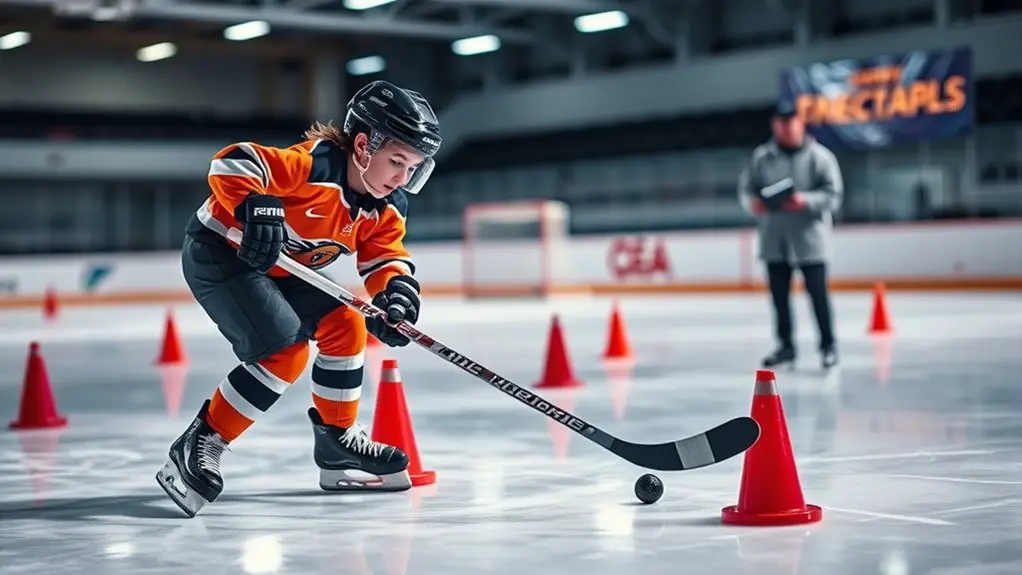Plyometric exercises are key for improving your foot speed. They utilize the stretch-shortening cycle to enhance power and reaction time, allowing for quicker, more agile movements. Incorporate drills like box jumps, squat jumps, and agility ladders into your routine to build explosive strength. Start gradually to avoid injury, focusing on form and landing softly. With the right approach, you'll see improvements in your speed and agility. There's more to learn about maximizing your plyometric training.
Understanding Plyometrics: The Science Behind Explosive Movement
When you think about explosive movement, it's hard not to contemplate plyometrics, which are designed to enhance your power and speed. These exercises focus on the stretch-shortening cycle, where your muscles rapidly lengthen and then contract, generating maximum force. This dynamic action taps into your body's natural capabilities, allowing you to leap higher and sprint faster. By engaging in plyometric training, you're not just building strength; you're unleashing your potential for quick, agile movements that give you the freedom to move effortlessly. Whether you're jumping, bounding, or hopping, each explosive motion trains your muscles to react faster, helping you break free from limitations. Embrace the science of plyometrics, and watch your foot speed soar!
Benefits of Plyometric Training for Athletes
While plyometric training is often associated with explosive power, its benefits extend far beyond just enhancing speed and strength for athletes. By incorporating these dynamic exercises into your routine, you'll improve your overall agility, coordination, and balance. This training enhances your muscle elasticity and efficiency, allowing for quicker movements and reduced injury risk. You'll also notice increased stamina, as plyometrics challenge your cardiovascular system, pushing your endurance to new heights. Furthermore, the mental aspect shouldn't be overlooked; the discipline and focus required during high-intensity plyometric workouts can boost your confidence and competitive edge. Ultimately, embracing plyometric training can liberate your athletic performance, enabling you to move freely and effectively on the field or court.
Key Plyometric Exercises to Boost Foot Speed
Plyometric exercises not only enhance overall athletic performance but are particularly effective for boosting foot speed. To get started, you can try box jumps, which develop explosive power and agility. Another great option is lateral bounds, helping you improve your side-to-side movement. For a dynamic challenge, incorporate squat jumps; these not only ramp up your speed but also strengthen your legs. Finally, consider using agility ladders for quick footwork drills that sharpen your reaction time. By regularly practicing these exercises, you'll build the strength and speed needed to elevate your game. Embrace the freedom these movements offer, and feel the exhilarating rush as you fly across the field or court, leaving your competition in the dust!
How to Incorporate Plyometrics Into Your Training Routine
To effectively incorporate plyometrics into your training routine, start by integrating these exercises gradually to avoid injury. Begin with one or two sessions a week, focusing on basic movements like box jumps or squat jumps. As you gain confidence and strength, you can increase the frequency and intensity. Mix plyometric drills with your existing workouts for a balanced approach—combine them with strength training or agility drills to enhance overall performance. Listen to your body; if something feels off, take a step back. Remember, you're aiming for improvement, not burnout. Finally, keep your workouts fun and engaging! Experiment with different exercises, and don't hesitate to adjust based on how you feel and what works best for you.
Safety Tips for Performing Plyometric Exercises
Integrating plyometrics into your routine can greatly boost your athletic performance, but safety should always come first. Start with a proper warm-up to prepare your muscles and joints. Make sure you have a stable surface to work on; uneven ground can lead to injuries. Focus on your form—landing softly with bent knees can help absorb impact and reduce strain. If you're new to plyometrics, ease into it; don't push your limits too quickly. Listen to your body; if you feel pain or discomfort, take a break. Finally, incorporate rest days to allow your muscles to recover. Remember, staying injury-free will keep you training and enjoying the freedom that comes with improved foot speed!
Progressing Your Plyometric Workouts
As you become more comfortable with plyometric exercises, it's essential to progressively challenge yourself to continue improving your foot speed and overall performance. Start by increasing the intensity of your workouts; add more repetitions or sets to push your limits. You might also incorporate variations like depth jumps or single-leg hops to engage different muscle groups. If you're feeling confident, try adding resistance through weighted vests or resistance bands. It's all about finding that sweet spot where you're pushing yourself without compromising form. Make sure to listen to your body, allowing adequate recovery time between sessions. Remember, the goal is to keep things fresh and invigorating while building your speed and agility. Enjoy the process, and let your progress unfold!
Measuring Your Improvement in Foot Speed
How can you tell if your foot speed is actually improving? One effective way is to time yourself during short sprints or agility drills. Start with a baseline measurement, then track your progress weekly. You'll quickly notice if you're cutting seconds off your times. Another method is to incorporate plyometric exercises, like box jumps or lateral hops, and assess how your body feels. If you're landing more efficiently and feeling lighter on your feet, that's a great sign. Additionally, consider having a training partner or coach observe your form and speed. They can offer valuable feedback. Ultimately, trust your instincts—if you feel faster and more agile, you likely are. Celebrate those small victories on your journey to freedom in movement!
Frequently Asked Questions
Can Plyometric Exercises Be Harmful for Beginners?
Jumping into plyometric exercises without proper guidance can be like diving into deep waters without knowing how to swim. If you're a beginner, it's essential to start slow to avoid injury and build confidence.
What Equipment Do I Need for Plyometric Training?
For plyometric training, you don't need much equipment. A sturdy surface, like a box or step, and resistance bands can enhance your workouts. Sneakers with good grip and space to move freely are essential, too.
How Often Should I Perform Plyometric Workouts?
You might think too much training could lead to burnout, but you can perform plyometric workouts two to three times a week. This frequency balances intensity and recovery, giving you freedom to improve without overdoing it.
Can Plyometrics Help With Agility and Coordination?
Yes, plyometrics can greatly enhance your agility and coordination. By incorporating explosive movements, you'll develop quicker reflexes and better body control, giving you the freedom to move more efficiently in various activities and sports.
Are There Age Restrictions for Performing Plyometric Exercises?
There aren't strict age restrictions for plyometric exercises, but it's wise to contemplate your fitness level and any pre-existing conditions. Always consult a professional to guarantee you're safely enjoying your training journey.




